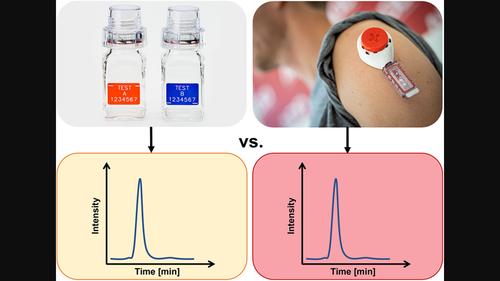当前位置:
X-MOL 学术
›
Drug Test. Anal.
›
论文详情
Our official English website, www.x-mol.net, welcomes your
feedback! (Note: you will need to create a separate account there.)
Detection of doping substances in paired dried blood spots and urine samples collected during doping controls in Danish fitness centers
Drug Testing and Analysis ( IF 2.6 ) Pub Date : 2024-03-04 , DOI: 10.1002/dta.3660 Maren Christin Stillesby Levernaes 1 , Sara A Solheim 1, 2 , Lillian Broderstad 1 , Essa Zandy 1 , Jakob Mørkeberg 2 , Yvette Dehnes 1
Drug Testing and Analysis ( IF 2.6 ) Pub Date : 2024-03-04 , DOI: 10.1002/dta.3660 Maren Christin Stillesby Levernaes 1 , Sara A Solheim 1, 2 , Lillian Broderstad 1 , Essa Zandy 1 , Jakob Mørkeberg 2 , Yvette Dehnes 1
Affiliation

|
The use of dried blood spot (DBS) in anti‐doping can be advantageous in terms of collection, transportation, and storage compared with the traditional anti‐doping testing matrices urine and venous blood. There could, nonetheless, be disadvantages such as shorter detection windows for some substances compared with urine, but real‐life comparison of the detectability of prohibited substances in DBS and urine is lacking. Herein, we present a liquid chromatography–high resolution mass spectrometry (LC‐HRMS)‐based screening method for simultaneous detection of 19 target analytes from the doping substance categories S1–S5 in a single spot. Ninety‐eight urine and upper‐arm DBS (Tasso‐M20) sample pairs were collected from fitness centers customers notified for doping control by Anti Doping Denmark, and three sample pairs were collected from active steroid users undergoing clinical evaluation and treatment at a Danish hospital. The analytical findings were cross compared to evaluate the applicability of the developed DBS testing menu in terms of feasibility and analytical performance. To our knowledge, this is the first study to compare the detectability of prohibited substances in DBS and urine samples collected in a doping control setting. Twenty‐seven of the urine samples and 23 DBS samples were positive, and we observed a very high concordance (95%) in the overall analytical results (i.e., positive or negative samples for both urine and DBS). Collectively, these results are very promising, and DBS seems suitable as a stand‐alone matrix in doping control in fitness centers likely because of the high analyte concentration levels in these samples.
中文翻译:

在丹麦健身中心的兴奋剂控制过程中收集的成对干血斑和尿液样本中检测到兴奋剂物质
与传统的反兴奋剂检测基质尿液和静脉血相比,干血斑(DBS)在反兴奋剂中的使用在采集、运输和储存方面具有优势。尽管如此,可能存在一些缺点,例如与尿液相比,某些物质的检测窗口较短,但缺乏对 DBS 和尿液中违禁物质检测能力的现实比较。在此,我们提出了一种基于液相色谱-高分辨率质谱 (LC-HRMS) 的筛选方法,用于在单个点中同时检测掺杂物质类别 S1-S5 中的 19 种目标分析物。 98 个尿液和上臂 DBS (Tasso-M20) 样本对是从丹麦反兴奋剂协会通知进行兴奋剂控制的健身中心客户中收集的,3 个样本对是从在丹麦一家医院接受临床评估和治疗的活跃类固醇使用者中收集的。对分析结果进行交叉比较,以评估开发的 DBS 测试菜单在可行性和分析性能方面的适用性。据我们所知,这是第一项比较 DBS 和在兴奋剂控制环境中收集的尿液样本中违禁物质的可检测性的研究。 27 个尿液样本和 23 个 DBS 样本呈阳性,我们观察到总体分析结果(即尿液和 DBS 样本均为阳性或阴性)的一致性非常高(95%)。总的来说,这些结果非常有希望,而且 DBS 似乎适合作为健身中心兴奋剂控制的独立基质,可能是因为这些样本中分析物浓度水平较高。
更新日期:2024-03-04
中文翻译:

在丹麦健身中心的兴奋剂控制过程中收集的成对干血斑和尿液样本中检测到兴奋剂物质
与传统的反兴奋剂检测基质尿液和静脉血相比,干血斑(DBS)在反兴奋剂中的使用在采集、运输和储存方面具有优势。尽管如此,可能存在一些缺点,例如与尿液相比,某些物质的检测窗口较短,但缺乏对 DBS 和尿液中违禁物质检测能力的现实比较。在此,我们提出了一种基于液相色谱-高分辨率质谱 (LC-HRMS) 的筛选方法,用于在单个点中同时检测掺杂物质类别 S1-S5 中的 19 种目标分析物。 98 个尿液和上臂 DBS (Tasso-M20) 样本对是从丹麦反兴奋剂协会通知进行兴奋剂控制的健身中心客户中收集的,3 个样本对是从在丹麦一家医院接受临床评估和治疗的活跃类固醇使用者中收集的。对分析结果进行交叉比较,以评估开发的 DBS 测试菜单在可行性和分析性能方面的适用性。据我们所知,这是第一项比较 DBS 和在兴奋剂控制环境中收集的尿液样本中违禁物质的可检测性的研究。 27 个尿液样本和 23 个 DBS 样本呈阳性,我们观察到总体分析结果(即尿液和 DBS 样本均为阳性或阴性)的一致性非常高(95%)。总的来说,这些结果非常有希望,而且 DBS 似乎适合作为健身中心兴奋剂控制的独立基质,可能是因为这些样本中分析物浓度水平较高。











































 京公网安备 11010802027423号
京公网安备 11010802027423号